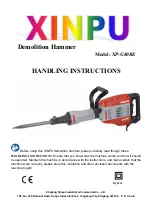
55
section 6
troubleshootinG
6.7 e-stop (emergency stop) and main contactor (k1a, k1b and k1c) circuits
A power-up sequence takes place before the Main Contactor (K1) activates. K1 is actually three separate contactors – one
for each primary input phase. Thus, K1A, K1B, and K1C switch phases A, B, and C respectively to the Main Transformer, T1.
The power-up sequence begins with a remote Contactor Signal activating K3 and K33. Refer to the description entitled,
Section 6.6, Auxiliary Main Contactor (K3 and K33) & Solid State Contactor Circuits for more information. K3 and K33 acti-
vates K2 closing the three contacts of K2. K2 bypasses K1 contacts providing primary input power to the Main Transformer,
T1. This current is limited by three one Ohm resistors, R1, R2, and R3. The resistors eliminate the high surge currents typical
of the turn-on inrush transients associated with large transformers. The high current surge of charging the Bus Capacitor
Bank is also eliminated by initially powering the Main Transformer through K2 and the resistors.
The discharged Bus Capacitor Bank initially prevents the output of the Main transformer from reaching its normal value.
As the Bus Capacitor Bank charges, the Main Transformer output voltage rises and becomes high enough for K1A, K1B, and
K1C to close. Once the K1’s are closed, the contacts of the Starting Contactor, K2, are bypassed, and full primary line power
is supplied to the Main Transformer through the contacts of the K1’s.
Because the starting sequence takes time, it is important at least 300 mS lapse between applying the Contactor Signal
and applying load to the power source. Applying load too soon will prevent the K1’s from closing and fuses F1 and F2 will
open.
K15, the E-Stop relay must be closed for the power-up sequence to take place. K15 contains one contact in the K2 coil circuit
and another contact in the K1A, K1B, & K1C circuits. There is no power supplied to the Main Transformer, T1, until K15 is acti-
vated. For K15 to activate, S5, the E-Stop switch on the front panel must be closed. Also, the Plasma Control must complete
the E-stop loop by closing an isolated contact between J1-E and J1-F.
The E-Stop switch is closed whenever the E-Stop button, on the front panel, is pulled out. For troubleshooting purposes
only, a jumper can be connected between TB8-18 and TB8-19. If a jumper is installed, it MUST be removed before placing
the power source back into service. If the jumper is not removed, the power source E-Stop condition will not function when
the E-Stop button for the Plasma Control is pushed.
J4-A and J4-B are connected together whenever the E-Stop button on the power source is pulled out. This signal can be
sent to the Plasma Control so that the control senses the state of the power source E-Stop switch.
Содержание Plasmarc EPP-601
Страница 1: ...EPP 601 Plasmarc RU 0558007979 06 2012...
Страница 2: ...52 529...
Страница 3: ......
Страница 4: ...4...
Страница 7: ...7 1 1 0 ESAB 1 B 2 3 4 5 IP 12 60 IP 23S 15 15...
Страница 8: ...8 1...
Страница 10: ...10 2 2 3 850 1143 mm 45 00 946 mm 37 25 1022 mm 40 25...
Страница 11: ...11 3 3 1 3 2 3 3 1 EPP 601...
Страница 12: ...12 3 3 4 3 4 1 EPP 601 3 I U x I x 0 68 U 2 2 EPP 601...
Страница 13: ...13 2 2 3 4 2 EPP 601 12 7 1 EPP 601 2 3 4 5 6 3 4 3 1 3 2 1 2 3 3 TB4 TB6...
Страница 14: ...14 3 5 3 5 1 600 4 0 AWG 400 600 100 4 0 AWG 600 100 3 3 5 2 1 2 3 UL 4 1...
Страница 15: ...15 3 EPP 600 3 6 100 100 600 4 0 AWG 600 14 AWG EPP 601 600 100 4 0 AWG 600 600 4 0 AWG...
Страница 19: ...19 3 3 7 24 8 3 7 1 4 647032...
Страница 20: ...20 3 4 3 7 2 647032 2010549 3 7 3 647257 2062105...
Страница 21: ...21 4 4 1 2 H 3 T1 300 375 300U120 0 0 10 0 I U x 80 High S T T T L1 L2 T T1 T1 425 250 R R EPP 601...
Страница 29: ...29 4 4 4 EPP 601 5 A 50 800 2 2 I 80 U I 10 U 800 I 80 U I 10 U...
Страница 31: ...31 4 4 4 4 38 4 4 5 PCB1 7 50 800 250 800 1200 90 80 70 60 50 40 30 20 10 0 0 1 2 3 4 5 6 7 8 9 10 SW1 SW2...
Страница 62: ...notes...










































